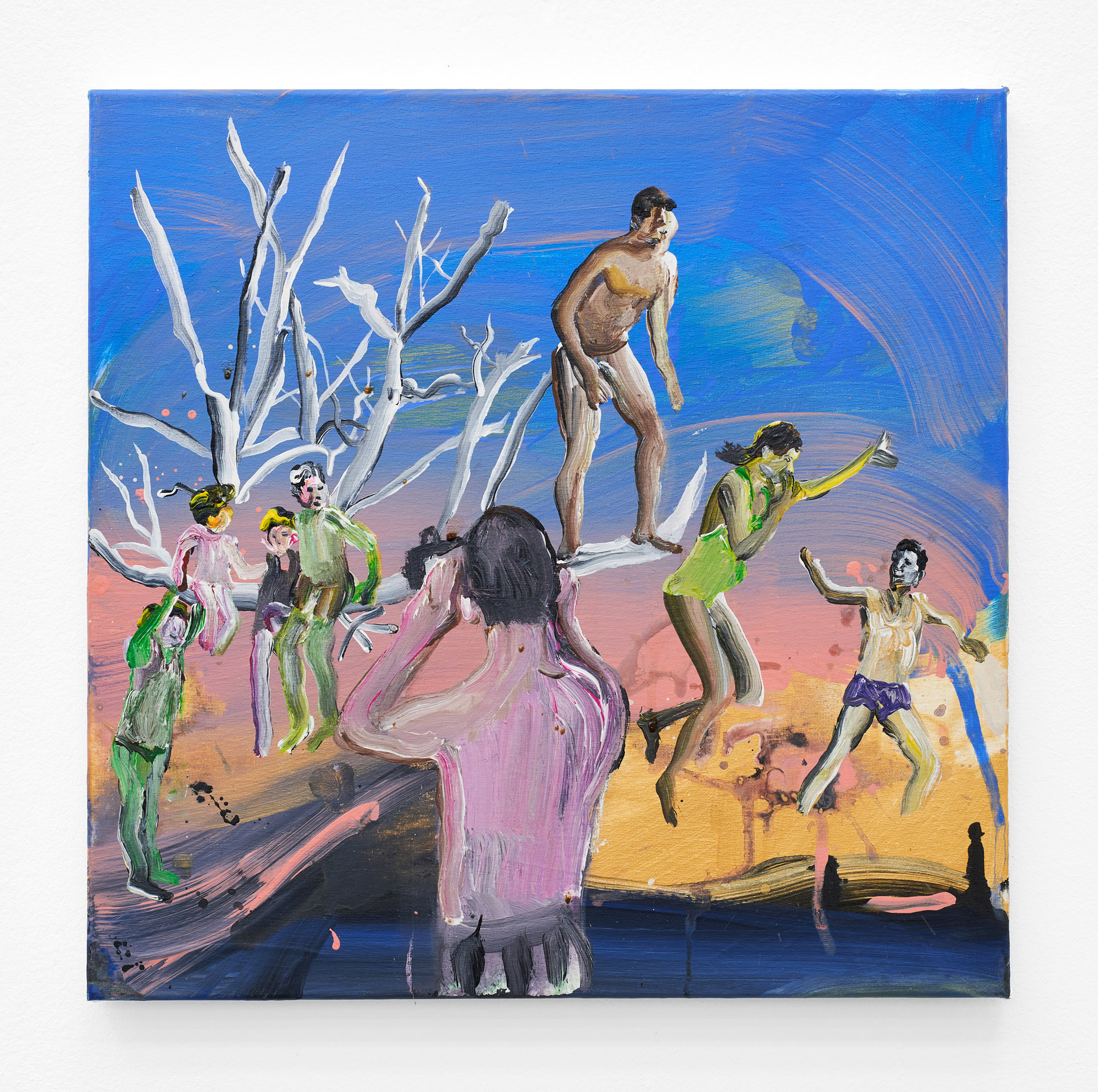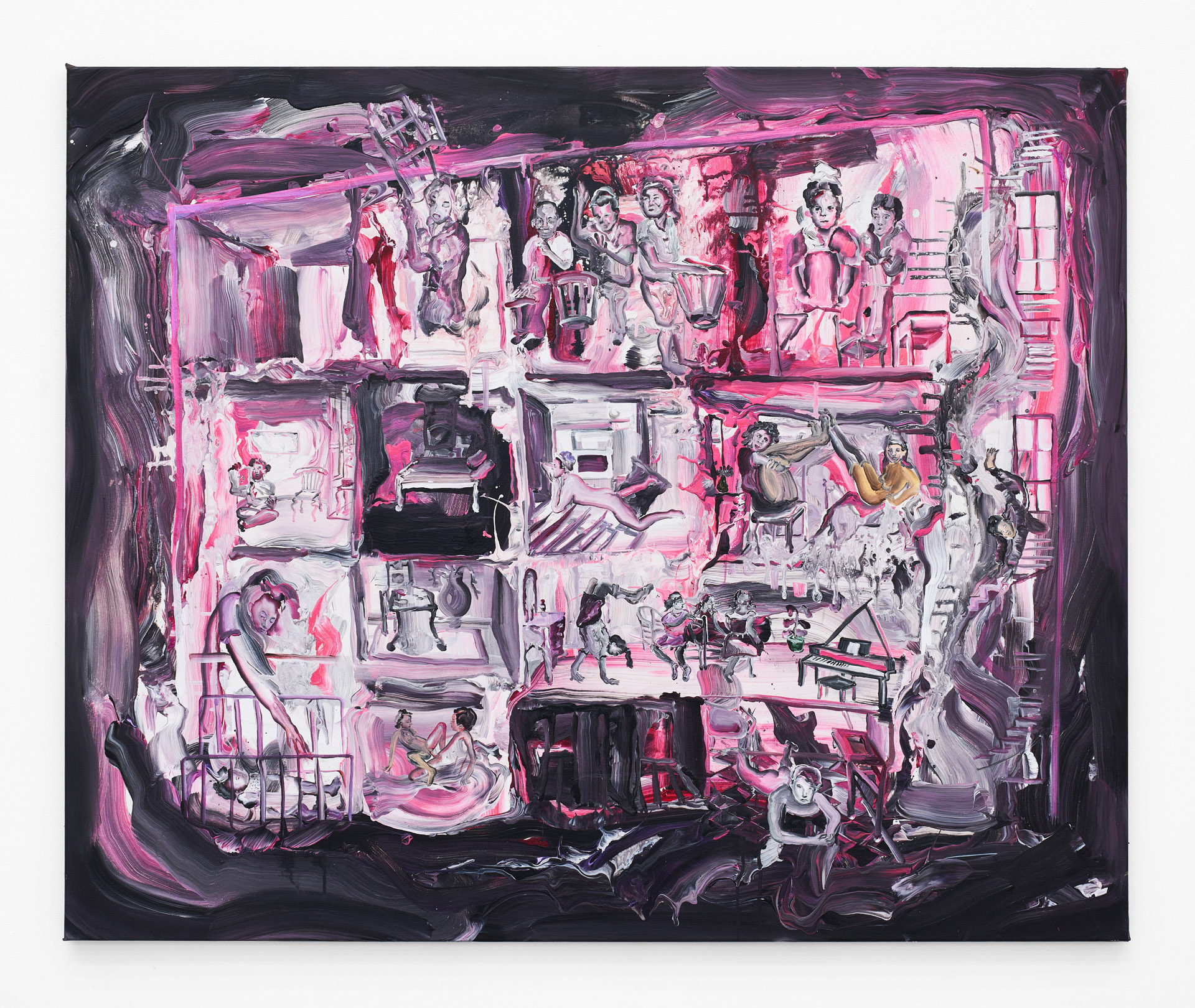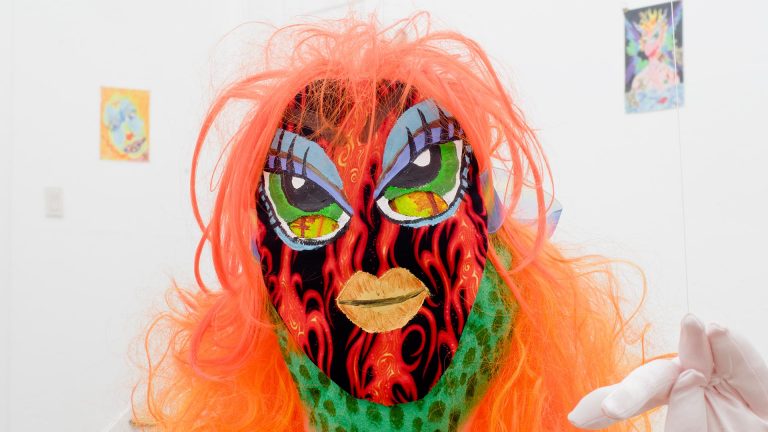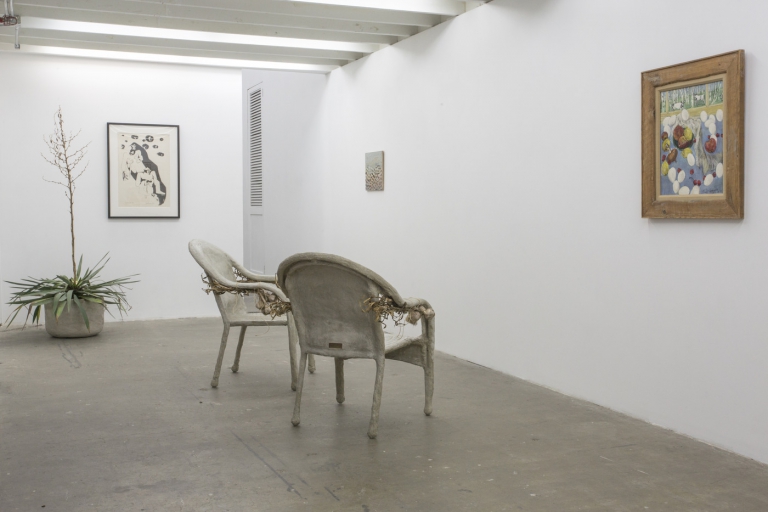Artist: Hend Samir
Exhibition title: Running in a Skewed Daydream
Venue: Harkawik, Los Angeles, US
Date: January 30 – February 27, 2021
Photography: all images copyright and courtesy of the artist and Harkawik, Los Angeles
Real Pain is deeply honored to announce Egyptian painter Hend Samir’s first solo exhibition in the United States—the spellbinding, beguiling, magnificent “Running in a Skewed Daydream.” Samir’s canvases teem with figures engaged in activities borne of her unique brushwork. Tender familial scenes, quotidian vignettes, forlorn visages, taboo sex, and moments of reverie and communal celebration are buttressed by a dappled maelstrom of paint that pushes and pulls at their arbitrary and socially contrived bounds. Utilizing the ornate trappings of her childhood home in Cairo, Samir presents us with a powerful meditation on the fragmentary character of domestic space as held in the nadir of the mind. Her figures are known to us as exclusively “in-process” apparitions, as are buildings, public spaces, vehicles and abstract piles that dissolve easily into one another. Color and scale are critical tools, and monochrome works are often broken by a single splash of color, a red herring that recalls a spotlight left accidentally trained on a stray stage prop. Breaking a long focus on modest canvases that function like family photos or mementos, Samir has created a mural to span the north wall of the gallery, inviting the viewer to enter into and move through the relational space of the painting, encountering its “doing” and “undoing” in real time. Devoid of their narrative trappings, Samir’s figures often face the viewer, happy not in the way of young people left to their own devices, but as we might like them to be: painfully innocent, participating reluctantly in the staged production of that which can be looked upon fondly at some point in the future. Samir is currently in residence at the Rijksakademie in Amsterdam.
Tala Madani & Hend Samir in Conversation
TM: Let’s start with the specificity of the figures in the paintings and their connection to the brush. They’re not depicting a photo-graphic reference, but rather sort of “emerge” as the brush meets the canvas and makes the face, hands, legs etc. This is where we can really follow your thinking as a painter.
HS: I always look at the small paintings and think, “if this brush stroke is huge, it is also going to work!” I’m using this swoosh in the background of the panoramas, and the huge brushes are helping. This is why I am working in panoramas, so I can create these narrative scenes, and also so the viewer can walk through the painting and see every-thing happening at scale.
TM: Tell me more about the panorama format. This is so interesting, the idea of walking and looking, not just to see, but to “make” the painting.
TM: Walking, seeing and memory are entangled. Your paintings seem to engage this relationship, with the body, the canvas, the viewer— a total landscape.
HS: Exactly. When I first made the panoramas, they were small. I could experience its totality immediately. But I wanted to be immersed. The next step was to enlarge them, add physicality, a gesture for the viewer to navigate the painting, not just with their eyes, but their body.
TM: Do you know the movie La Ciénaga? It’s an Argentinian film made by Lucretia Martel, it means “The Swamp.” Your figures remind me of the figures in this movie— the way they sit leisurely, sexually, lazily. And the only thing that could awaken them is sex or fear. In these figures, and in yours, I’m struck by the precariousness of bodies waiting.
HS: Yes. I connect this kind of sexuality with fear and intimidation, like there is something more than pure pleasure that’s happening and motivating these scenes.
TM: Right. And it connects to the youthful-ness of your characters. They resonate with teenage energy, the kind of energy that’s expressing and experiencing new, oozing-all-over-the-place kinds of feelings. It’s volatile, it’s raw.
HS: I’m looking at the people around me, like the adolescence in Egypt. It’s an energetic thing; they give off an essence of experience beyond their years, an internal wrestling.
TM: As an adolescent, in a family context, you are a captive.
HS: And even more so, I find that in Egypt, the family unit is so sacred. More than media, the government— life is oriented around the family.
TM: Yes. I’m looking at your painting, A Turbulent Building. It depicts a scene, a scan or cut up of an apartment building, in heavy reds and blacks. It’s buttery.
TM: And I get a sense it was made in one second, and of course it was not. But, it’s as if you held on to a singular constant energy throughout the duration of the painting. Like a weightlifter, holding up a dumbbell for an extended time.
HS: There’s always an energetic moment that is completed in a painting. I have to react and react to the reaction. I say to the painting, “what are you asking me to do?”
TM: Yes. This work, A Turbulent Building, is also reminiscent of Hitchcock’s Rear Window. Looking in and at life from afar. Your painting and its symbols, the piano, the spiral staircase, it’s gushing.
HS: Yes! The staircase began as this reference, this portal to the inside or outside of the building and the painting itself. I understand that the people I’m painting are performers, aware they are being viewed. Simultaneously they merge with their fictions and become more awkward in their exhibitionism.
TM: There’s a rich history of performative figurative painting, specifically because painters were painting from life, from models. The surface plays a large role in your work too, is it canvas or paper?
HS: I paint on unstretched canvas, on the floor. It’s easier for me to move around and reach all areas of the painting that way. I can look over them, step over them.
TM: In this way you invite chance. You lessen your control or play with your own control.
HS: I’m using gravity as a tool when I’m standing over the paintings.
TM: I see that here, in the painting Family Tree, which portrays figures jumping from a tree into the water, while a man, back to us, takes a photo. The gravity of the brush-work—responding to the brush itself. What is effective in your work is the understanding of contrast. Your implementation of high contrast pushes the colors back and forth, I think, “ this scene is dynamic and alive.”
HS: I’m interested in the interplay of re-pulsion and attraction. As I work I’m think-ing “what stays a leg or an arm? What gets washed away into the background. What goes inside to the painting itself?” The paintings also allow the figures, the children, to be transported into a space that has nothing to do with this reality. An intimacy is created that you wouldn’t see, or wouldn’t see sustained.
TM: Using children as a device to disarm. That’s interesting and also historical. It reminds me of The Boondocks, originally a comic strip in the 90’s then animated series that uses children as non threatening actors to voice disapproval of their situation. And it’s used politically, I remember themes around 9/11 and it’s format to deescalates the response to criticisms against George W Bush. It’s psychologically powerful. Who doesn’t have a relationship to youth, to family, or the symbolism of a family photo. I’d love to hear more about what you were saying about creating new realities, spaces of make believe.
HS: This comes out in the interplay of space itself. Architecture may infer safety or structure. The outside, or its border may infer threat. I’m putting pressure on this boundary, the inside and outside. For example, there can be a scene of people eating, and suddenly there are waves of sky that create a couch and children pulling a table with a child trapped inside. It’s an offering. A code. A way to build a narrative. I’m interested in the references of loaded objects, like a colonial serving tray, and how to subvert them.
TM: And your framing is great. You conduct a diverse reconnaissance of references and fuse them into cohesion. Your enjoyment and play with the materiality really comes through. It’s alchemical.
HS: Thank you.
Hend Samir, Running in a Skewed Daydream, 2021, exhibition view, Real Pain, Los Angeles
Hend Samir, Running in a Skewed Daydream, 2021, exhibition view, Real Pain, Los Angeles
Hend Samir, Running in a Skewed Daydream, 2021, exhibition view, Real Pain, Los Angeles
Hend Samir, Running in a Skewed Daydream, 2021, exhibition view, Real Pain, Los Angeles
Hend Samir, Running in a Skewed Daydream, 2021, exhibition view, Real Pain, Los Angeles
Hend Samir, Running in a Skewed Daydream, 2021, exhibition view, Real Pain, Los Angeles
Hend Samir, Running in a Skewed Daydream, 2021, exhibition view, Real Pain, Los Angeles
Hend Samir, Family Love Parade, 2020, 17″ H x 21″ W, Acrylic on canvas
Hend Samir, Running in a Skewed Daydream, 2021, exhibition view, Real Pain, Los Angeles
Hend Samir, Misson, Accomplished, 2020, 17″ H x 21″ W, Acrylic on canvas
Hend Samir, Untitled (Mural 3), 2020, 81.5″ H x 260″ W, Acrylic on canvas
Hend Samir, Running in a Skewed Daydream, 2021, exhibition view, Real Pain, Los Angeles
Hend Samir, Running in a Skewed Daydream, 2021, exhibition view, Real Pain, Los Angeles
Hend Samir, Family Tree, 2018, 15″ H x 15″ W, Acrylic on canvas
Hend Samir, Running in a Skewed Daydream, 2021, exhibition view, Real Pain, Los Angeles
Hend Samir, Running in a Skewed Daydream, 2021, exhibition view, Real Pain, Los Angeles
Hend Samir, Running in a Skewed Daydream, 2021, exhibition view, Real Pain, Los Angeles
Hend Samir, New Arrival, 2018, 15″ H x 15″ W, Acrylic on canvas
Hend Samir, Running in a Skewed Daydream, 2021, exhibition view, Real Pain, Los Angeles
Hend Samir, Running in a Skewed Daydream, 2021, exhibition view, Real Pain, Los Angeles
Hend Samir, Running in a Skewed Daydream, 2021, exhibition view, Real Pain, Los Angeles
Hend Samir, A Turbulent Building, 2020, 55″ H x 67″ W, Acrylic on canvas
Hend Samir, Young Love Story, 2020, 17″ H x 21″ W, Acrylic on canvas





























